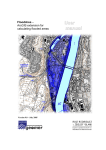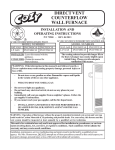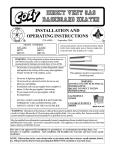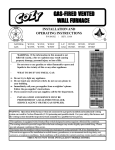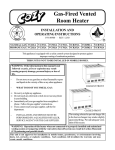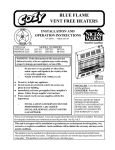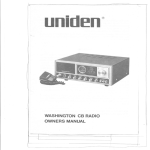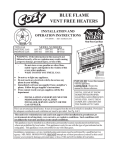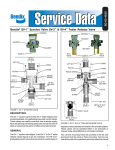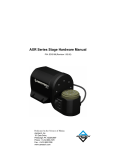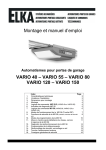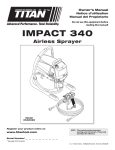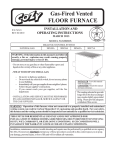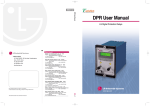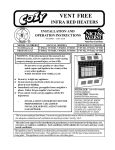Download Louisville Tin and Stove HEDV403 User's Manual
Transcript
hi-efficient direct vent wall furnace INSTALLATION AND OPERATING INSTRUCTIONS R P/N 72903 MODEL NUMBERS NAT. GAS L.P. GAS HEDV403 HEDV404 / December 2003 R INSTALLER MUST LEAVE THESE INSTRUCTIONS WITH THE CONSUMER, HAVE THEM COMPLETE, AND RETURN THE WARRANTY CARD. WARNING: If the information in these instructions are not followed exactly, a fire or explosion may result causing property damage, personal injury or loss of life. Do not store or use gasoline or other flammable vapors and liquids in the vicinity of this or any other appliance. WHAT TOuse DOgasoline IF YOUorSMELL GAS: - -Do not store or other flammable vapors and liquids in the vicinity of this or any •other Do not try to light any appliance. appliance. • Do notDO touch any electrical - WHAT TO IF YOU SMELL switch; GAS: do not use any phone in your building. • Immediately supplier from a neighbor’s Do not try to call lightyour any gas appliance. phone. Follow the gas supplier’s instructions. Do not touch any electrical switch; do not • If you your gas supplier, call the use anycannot phonereach in your building. fire department. Immediately call your gas supplier from a - neighbor’s phone. Follow the gas INSTALLATION AND SERVICE MUST BE PERsupplier’s instructions. FORMED BY A QUALIFIED INSTALLER, If you cannot reach your gas supplier, call SERVICE AGENCY OR THE GAS SUPPLIER. the fire department. WARNING: Operation of this furnace without the properly installed, factory furnished vent system and vent cap could result in Carbon Monoxide (CO) poisoning and possible death. For your safety, this furnace and the vent system should be inspected at least annually by a qualified service person. May be installed in an aftermarket, permanently located, manufactured home (mobile home) where not prohibited by local codes. See owner’s manual for details. This appliance is not convertible for use with other gases, unless a certified kit is used. This unit is not approved for installation in greenhouses, or environments involving dusty, wet, corrosive, or explosive conditions. Such conditions will invalidate the warranty and may create unsafe conditions. CONTENTS Introduction…………………………….. Specifications and Dimensions…………. Safety Rules…………………………….. Clearances………………………………. Location………………………………… Installation……………………………… Lighting Instructions…………………… Pilot Adjustment……………………….. Burner Orifice………………………….. 2 2 3 4/5 6 7 10 11 11 Wiring Diagram………………………… Removing Main Burner………………… Proper Burner Flame…………………… Sequence of Operation…………………. Optional Kits…………………………… Trouble Shooting………………………. Parts Drawing………………………….. Parts List……………………………….. Warranty……………………………….. 12 11 11 13 14 17 19 20 22 INTRODUCTION THIS IS A GAS-FIRED DRAFT INDUCED, POWER DEPENDENT DIRECT VENT WALL FURNACE THAT WILL OPERATE SAFELY AND PROVIDE AN EFFICIENT SOURCE OF HEAT WHEN INSTALLED, OPERATED AND MAINTAINED AS RECOMMENDED IN THESE INSTALLATION AND OPERATING INSTRUCTIONS. READ THESE INSTRUCTIONS THOROUGHLY BEFORE INSTALLING, SERVICING, OR USING THE APPLIANCE. IF YOU DO NOT UNDERSTAND ANY PART OF THESE INSTRUCTIONS CONSULT LOCAL AUTHORITIES, OTHER QUALIFIED INSTALLERS, SERVICE AGENCIES, THE GAS SUPPLIER OR THE MANUFACTURER. SPECIFICATIONS AND DIMENSIONS Your Direct Vent Wall Furnace is shipped complete in one carton. This carton contains the furnace, vent cap, vent exhaust tube, air inlet tube, template with rough-in dimensions, installation and operating instructions, and the thermostat. MODEL NO. INPUT BTU/HR. WIDTH DEPTH HEIGHT GAS CONN. TYPE GAS HEDV403 40,000 34-1/2” 9” 30” 1/2” Nat. 32” 5” HEDV404 40,000 34-1/2” 9” 30” 1/2” L.P. 32” 5” Page 2 MAX. WALL Thickness MIN. WALL Thickness SAFETY RULES 1. 2. 3. 4. 5. 6. 7. 8. 9. 10. 11. 12. 13. 14. 15. 16. 17. 18. 19. 20. 21. 22. 23. 24. Improper installation, adjustment, alteration, service, or maintenance can cause property damage, bodily injury, or death. Use in other than a residential application may result in unsatisfactory performance and may void the warranty. Follow all applicable codes and ordinances. If there are none, follow the latest edition of National Fuel Gas Code ANSI Z223.1 A copy may be obtained from the CSA International, or the National Fire Protection Association, Batterymarch Park, Quincy, MA. 02269. In Canada, use latest edition of CAN1-B149 installation code. DO NOT INSTALL THIS FURNACE IN A RECREATIONAL VEHICLE OR TRAILER. Do not operate wall furnace unless it is connected to the supplied vent system with vent cap in place. Check the rating label attached to the wall furnace to be sure it is equipped for the type gas you intend to use. Never use a match, candle, flame or other source of ignition to check for gas leaks. Use only soapy water or liquid detergent. Have your wall furnace and vent system inspected at least annually by a qualified service technician. Before cleaning or servicing, turn off the gas and allow furnace to cool. Do not operate wall furnace without all components properly installed (top, front, etc.). Due to high temperatures, the wall furnace should be located out of traffic and away from furniture and drapes. Children and adults should be alerted to the hazard of high surface temperature and should be kept away to avoid burns or clothing ignition. Young children should be carefully supervised when they are in the same room with the wall furnace. Do not place clothing or other flammable material on or near the furnace. INSTALLATION AND REPAIR SHOULD BE DONE BY A QUALIFIED SERVICE PERSON. THE WALL FURNACE SHOULD BE INSPECTED BEFORE USE AND AT LEAST ANNUALLY BY A PROFESSIONAL SERVICE PERSON. More frequent cleaning may be required due to excessive lint from carpeting, bedding material, etc. It is imperative that control compartments, burner, and circulating air passageways of the furnace be kept clean. Do not install in a closet, alcove, or small hallway where the furnace could be isolated from the space to be heated by closing a door. Do not put anything around the furnace or vent cap that will obstruct the flow of combustion and ventilation air. The appliance, when installed, must be electrically grounded in accordance with local codes or, in the absence of local codes, with the latest edition of National Electrical Code, ANSI/NFPA 70. In Canada, use CSA C22.1. Never operate this furnace without the sight glass in place or with the glass broken or missing. If it is suspected that rising water may enter the furnace, turn off the gas immediately. Do not use the appliance if any part has been under water. Immediately call a qualified service technician to inspect the appliance and to replace any part of the control system and any gas control which has been under water. It is necessary to replace damaged gaskets or sealing material within the vent or air intake system. Failure to do so may result in property damage, personal injury or loss of life. Any safety screen or guard removed for servicing must be replaced prior to operating heater. This appliance must not be connected to a chimney flue serving a separate solid fuel burning appliance. Page 3 Vent Terminal Air Supply Inlet Area where terminal is not permitted VENT TERMINAL CLEARANCES REFERENCE LETTER TO DRAWING A = Clearance above grade, veranda, porch, deck, or balcony B = Clearance to window or door that may be opened C = Clearance to permanently closed window D = Vertical clearance to ventilated soffit located above the terminal within a horizontal distance of 2 Feet (61 cm) from the center line of the terminal E = Clearance to unventilated soffit F = Clearance to outside corner G = Clearance to inside corner H = Clearance to each side of center line extended above meter/ regulator assembly I = Clearance to service regulator vent outlet J = Clearance to nonmechanical air supply inlet to building or the combustion air inlet to any other appliance K = Clearance to a mechanical air supply inlet L = Clearance above paved sidewalk or paved driveway located on public property CANADIAN INSTALLATIONS¹ 12 Inches (30 cm) 12 Inches (30 cm) 12 Inches (30 cm) 18 Inches (46 cm) 18 Inches (46 cm) 12 Inches (30 cm) 12 Inches (30 cm) 3 Feet (91 cm) within a hei 15 Feet (4.5m) above the meter/regulator assembly 3 Feet (91 cm) 12 Inches (30 cm) 6 Feet (1.83 m) 7 Feet (2.13m) A vent shal not terminate directly abo a sidewalk or paved drivew t db t t th t i l Page 4 CLEARANCES 1. 2. 3. 4. 5. 6. As you face the heater, the clearance to a side wall on the right side is 0” (Fig. 1), and the left side is 1” (Fig. 2). The minimum clearance from the top of the heater to the ceiling or any projecting overhang is 10”. (See Figure 3). The minimum clearance from the bottom of the heater to the floor, or the top surface of carpeting, tile, etc. is 0”. (See Figure 4). When the furnace is installed directly on carpeting, tile or other combustible material other than wood flooring, the furnace shall be installed on a metal or wood panel extending the full width and depth of the furnace. The minimum clearance from the edge of the vent cap to any overhanging obstruction, perpendicular side wall, or corner of building is 12”. (See Figure 5). Vent cap must be located at least 9” from any opening that would allow combustion products to enter the building, windows, doors, etc., and 12” above the ground or shrubbery (See Figure 5). Do not install vent cap in a window well. Provisions must be made to prevent snow accumulation from infringing on vent cap clearances. 1” (2.54 cm) Ceiling or Overhang 10” (25.4 cm) Side Wall FIGURE 1 FIGURE 2 FIGURE 3 FIGURE 5 Page 5 CLEARANCES 7. RESIDENTIAL GARAGE INSTALLATION: Gas utilization equipment in residential garages shall be installed so that all burners and burner ignition devices are located not less than 18 inches (46 cm) above the floor. You must build a platform 18” above floor, the full width and depth of the heater, including the rear trim kit. HEATER IS NOT DESIGNED TO HANG ON WALL. Unit should be located or protected so it is not subject to damage by a moving vehicle. Use care in selecting a good location whith in the grage. DO NOT locate the appliance where heated air will be directed onto a nearby parked vehicle. Paint may discolor or rubber may harden and crack. DO NOT allow open or closed containers of paint, gasoline or other liquids having flammable vapors to be stored or used in the same area as the heater. LOCATION 1. 2. 3. The wall furnace must be installed on an outside wall, unless optional Kit No. HEVK-5 is used. For most efficient performance, locate furnace as centrally as possible in the area to be heated and where occupants may move about freely without coming into contact with the cabinet, and within reach of a 115V wall outlet. If the furnace is installed in a basement, a 12” clearance must be maintained between ground level and the bottom of the vent cap. Do not install furnace where vent cap will terminate in a window well or any other opening below ground level. Do not allow snow accumulation to build up within 12” of the vent cap. OPTIONAL KITS 1. HEVK-5 - To extend vent 5 foot from heater. This will allow vent cap to be installed above grade from basement or to an outside wall. A total of 3 kits with 2 additional elbows may be used. 12” Minimum above grade without excavation Page 6 INSTALLATION Failure to follow these instructions carefully could result in poor performance, property damage, personal injury, or death. STEP 1. LOCATE VENT OPENING (Requires 3-1/2” diameter wall opening) a) Select area on wall where heater will be installed. Using template (packed with heater) mark shaded area where hole can be cut and to locate the wall brackets. b) Locate studs on each side of this area. c) Mark location for 3-1/2” diameter hole between studs. Hole should be offset to miss studs. (See Figure 6). d) Check outside wall at this location for proper clearances around vent cap. e) Cut vent openings into both the inside and outside walls, being sure to maintain level across both openings. Template Shaded Area Wall Studs 16” O.C. FIGURE 6 1/8” N.P.T. Plugged Hole for Pressure Gauge Gas Valve Manual Shut Off Valve Ground Joint Union Gas Supply Inlet 3” (76mm) Min. FIGURE 7 STEP 2. ROUGH-IN GAS SUPPLY (See Figure 7) a) Install a 1/2” gas supply line. The gas line will enter the heater from the 5” spacing between the heater back and the wall. b) Install a drip leg in gas supply line immediately upstream from the gas connection to heater, (see local codes), and provide a 1/8” N.P.T. plugged tapping, accessible for test gauge connection and a individual manual shut off valve. The furnace and its individual shut off valve must be disconnected from the gas supply piping system during any pressure testing of that system at test pressures in excess of 1/2 psig (3.5Pa). The furnace must be isolated from the gas supply piping system by closing its individual manual shut off valve during any pressure testing of the gas supply piping system at test pressures equal to or less than 1/2 psig (3.5Pa). Page 7 INSTALLATION - CONTINUED STEP 3 INSTALLING VENT SYSTEM 5” - 32” WALL THICKNESS (12.7 cm - 81.3 cm) a) Use only factory supplied parts. Do not attempt to modify in any way. To do so could cause a system imbalance resulting in poor performance and/or unsafe operating conditions. b) Slide collection box pipes through cutout and secure collection box to inside wall. Anchors (not supplied) may be required. (See Figure 8). c) From outside house, mark collection box pipes and cut off 1/2” beyond outside wall. d) Slide vent cap pipes onto collection box pipes and push in until flange is flush against house. Secure vent cap assembly to outside wall with a slight downward slope. This will prevent water from entering and allow and condensation to drain. Caulk around the edges of the vent cap mounting plate. NOTE: It may be necessary to build a metal or wood frame to provide a flat surface for the mounting plate to be flush against or to attain the 5” minimum wall thickness. Collection Box Assembly Vent Cap Assembly BRACKETS Vent Cap Mounting Plate FIGURE 9 Page 8 STEP 4. INSTALLING HEATER a) Screw wall brackets to wall. Location marked with template. (See Step 1a) b) Screw trim kit brackets to back of heater. (See Figure 9). c) Slide heater to within approximately 5” from wall. d) Attach air intake hose to collector box outlet and burner box inlet with clamps provided. (See Figure 10). e) Attach vent exhaust tube to exhaust pipe on collector box and draft inducer outlet on back of heater. Secure with clamps provided. (See Figure 10). f) GAS CONNECTION. Make gas connection between manual shut off valve and furnace valve with approved connectors. Compounds used on threaded joints of gas piping shall be approved for use with L.P. gas. The gas lines must be checked for leaks by the installer with soapy water or liquid detergent, never an open flame. If connections are not exposed, a pressure test must be run. Be sure to disconnect the gas supply line from the appliance valve before pressure testing. The manifold pressure is pre-set at the factory and should be 3.5” w.c. for Natural Gas and 10” w.c. for L.P. gas. The minimum inlet pressure for Natural Gas is 4.5” w.c. and 11” w.c. for L.P. Gas, “for purpose of input adjustment”. The maximum inlet pressure should never exceed 7.0” w.c. on Natural Gas or 14” w.c. on L.P. Gas. STEP 5. INSTALLING REAR TRIM KIT a) Secure right and left trim kit sides to the wall and trim kit brackets with eight #8 screws provided. See figure 11. The back of the heater should now be spaced 5” from the wall. b) Remove the temperature sensing unit from the back of the heater. Save the nylon attachment clip and the #8 screw. c) Slide the temperature sensing unit through the 1/2” bushing located on the right trim kit side. Viewed from the front of the heater. d) Secure the temperature sensing unit to the outside of the right trim kit side using the nylon clip and #8 screw saved from step B. Engagement hole provided. e) Secure trim kit top panel to trim kit sides with four #8 screws provided. f) Plug power supply cord into a 115V grounded electrical outlet. g) Turn the manual gas supply valve to the “on” position. HEATER IS NOW INSTALLED, FOLLOW LIGHTING INSTRUCTIONS. Trim Kit Top t Uni g n i s Sen ure t a r pe Tem Trim Kit Right Side 1/2” Bushing Trim Kit Left Side Trim Kit Bracket (4) FIGURE 11 Page 9 FOR YOUR SAFETY READ BEFORE OPERATING WARNING: If you do not follow these instructions exactly, a fire or explosion may result causing property damage, personal injury or loss of life. A. B. This appliance does not have a pilot. It is equipped with an ignition device which automatically lights the burner. Do not try to light the burner by hand. • If you cannot reach your gas supplier, call the fire department. C. Use only your hand to push in or turn the gas control knob. Never use tools. If the knob will not push in or turn by hand, don’t try to repair it, call a qualified service technician. Force or attempted repair may result in a fire or explosion. D. Do not use this appliance if any part has been under water. Immediately call a qualified service technician to inspect the appliance and to replace any part of the control system and any gas control which has been under water. BEFORE OPERATING smell all around the appliance area for gas. Be sure to smell next to the floor because some gas is heavier than air and will settle on the floor. WHAT TO DO IF YOU SMELL GAS: • Do not try to light any appliance. • Do not touch any electric switch; do not use any phone in your building. • Immediately call your gas supplier from a neighbor’s phone. Follow the gas supplier’s instructions. OPERATING INSTRUCTIONS 1. 2. 3. 4. STOP! Read the safety information above on this label. Set the thermostat to lowest setting. Turn off all electric power to the appliance. This appliance does not have a pilot. It is equipped with an ignition device which automatically lights the burner. Do not try to light the burner by hand. 5. 6. 7. 8. Gas Inlet Gas control knob shown in “OFF” position 9. 10. 11. 12. Remove front panel. Pull the gas control lever DOWN clockwise $ to “OFF”. Do not force. Wait five (5) minutes to clear out any gas. Then smell for gas, including near the floor. If you smell gas, STOP! Follow “B” in the safety information above on this label. If you don’t smell gas, go to the next step. Push gas control lever UP counterclockwise % to “ON”. Replace front panel. Turn on all electric power to the appliance. Set thermostat to desired setting. If the appliance will not operate, follow the instructions “To Turn Off Gas To Appliance” and call your service technician or gas supplier. TO TURN OFF GAS TO APPLIANCE 1. 2. 3. Set the thermostat to lowest setting. Turn off all electric power to the appliance if service is to be performed. Remove front panel. 4. 5. Page 10 Pull the gas control lever DOWN clockwise $ to “OFF”. Do not force. Replace front panel. PROPER BURNER FLAME Primary Flame The burner flame may be observed by raising the sight glass cover. A proper flame will have a dark blue inner mantle, with a lighter blue outer mantle that extends from the burner into the heat exchanger tube, (see Figure 12). There is no primary air adjustment on the burner, and proper flame is assured since the correct manifold pressure and orificing has been done at the factory. Burner Secondary Flame Heat Exchanger Tube TO REMOVE MAIN BURNER FOR INSPECTION AND CLEANING 1. 2. 3. 4. 5. 6. 7. 8. 9. 10. 11. Turn off all electrical supply to heater. Turn off gas supply. Remove front panel. Unplug wire to ignitor and sensor. (See Fig. 13.) Disconnect vacuum hose from burner box. Remove screws holding burner box top to burner box. (See Figure 13.) Remove burner plate and burner box top. Take care not to contact, or strain ignitor in any way as it is extremely fragile. (See Figure 13.) Remove 2 nuts holding burner bracket. (See Figure 13). Slide burners toward heat exchanger and lift up from rear and back. (See Figure 13). Clean or replace as needed. Reinstall by reversing Steps 9 - 1. BURNER ORIFICE This appliance is orificed at the factory for elevations up to 2,000 ft. If installed above 2,000 ft., the BTU input must be reduced 4% per 1,000 ft. See the following orifice chart for the proper orifice for a specific elevation. SPECIFIC ELEVATIONS MODEL NO. 0 to 2,000’ HEDV403 45 2,000’ 4,000’ 4,000’ 6,000’ 6,000’ 8,000’ 8,000’ 10,000’ 49 50 56 57 FIGURE 12 NOTE: THE FURNACE AND ALL COMPONENTS MUST BE INSPECTED AT LEAST ANNUALLY BY A QUALIFIED SERVICE PERSON. THIS SHOULD INCLUDE THE BURNER, HEAT EXCHANGER, AND VENT SYSTEM. BE SURE THAT THE FLOW OF COMBUSTION AND VENTILATION AIR ARE NOT OBSTRUCTED AND THAT ALL HOSES ARE UNDAMAGED, AND ALL CLAMPS ARE SECURELY TIGHTENTED. Valve Burner Box Top Burner Box Plate Burner Sensor Manifold Nut Burner Bracket Ignitor Vacuum Hose FIGURE 13 NATURAL GAS 47 48 L.P. GAS HEDV404 55 55 56 NOTE: If this heater is installed above an elevation of 8,000 feet, the factory installed pressure switch may not function properly. If you experience a problem with the pressure switch, contact a qualified service agency to replace the factory installed pressure switch with a high altitude pressure switch P/N 72521. To order see your local Cozy dealer or contact the factory. Page 11 WIRING WARNING THIS IS A GAS-FIRED APPLIANCE. KEEP THE AREA CLEAR OF GASOLINE AND OTHER FLAMMABLE VAPORS AND LIQUIDS. ALL COMBUSTIBLE MATERIAL MUST BE KEPT CLEAR OF THIS AREA TO AVOID FIRE OR EXPLOSION. This appliance is equipped with a three prong grounding plug. For your protection against shock hazard, this appliance should be plugged directly into a properly grounded three-prong receptacle. Do not cut or remove the grounding prong from this plug. NOTE: If any of the original wire supplied with this appliance has to be replaced, it must be replaced with type 105-C wire or its equivalent. CAUTION: Label all wires prior to disconnection when servicing controls. Wiring errors can cause improper and dangerous operation. Verify proper operation after servicing. Gas Valve Blue Blue Black Black Draft Inducer Yellow Yellow White Red C R Y Black White Yellow Yellow White 24 VAC White Black Pressure Switch Gas Valve Brown High Limit MODEL HEDV 403, 404 Page 12 Draft Inducer Flame Sensor Red Black White Green Red Secondary 24 VAC Limit Switch Neutrals Transformer Transformer Thermostat Heat Hum M1 M2 W Thermostat 115 VAC Primary 3 Amp Fuse Circulating Blower EAC/LSPD Ignitor Flame Sensor XFMR L1 Ignitor Circulating Blower Pressure Switch White SEQUENCE OF OPERATION - HEDV403/4 @t=0 THERMOSTAT CALLS FOR HEAT Power to Combust. Fan t=10 sec. Fan Proved YES t=15 sec. Power to Ignitor Gas Flow t=20 sec. IGNITION YES PROVED? t=50 sec. @t=X Thermostat is satisfied t=x sec. Blower On Burners Off t=X+15 sec. Combust. Fan Off t=X+120 sec. Blower Off NO NO NO 10 SEC PURGE NO Three Attempts Made? Lockout YES Three Attempts Made? 10 SEC PURGE YES STEP # 1) Thermostat calls for heat. 2) Combustion fan turns on. 3) Pressure switch closes. 4) Power to Ignitor. 5) Ignitor warm up period. 6) Gas flow to burner. 7) Burner ignition proven. 8) Circulating blower on. NOTE: If there is a malfunction in any of the above steps, the sequence will stop at that point and STEP # 8) Continued... return to Step 2. If after 3 attempts malfunction still occurs, furnace will go into lockout mode for one hour. This one hour mode can be bypassed by resetting thermostat. 9) Thermostat satisfied. 10) Gas valve closes. 11) Combustion fan off. 12) Blower off. HEATER NOW IN STAND-BY MODE. Page 13 HEVK-5 5’ VENT EXHAUST KIT INSTALLATION INSTRUCTIONS WARNING: Use only Louisville Tin & Stove Company factory supplied parts and kits. Failure to do so could result in loss of life, personal injury, property damage, or unsatisfactory performance. CONTENTS OF KIT 1 only P/N 72532 2”x3” Steel Coupling 1 only P/N 41520 Center Bracket 1 only P/N 72575 2”x5’ Black Flocked Tube 8 only P/N 72593 2” Hose Clamps 1 only P/N 72612 2”x6’ Black Flex Tubing 1 only P/N 72578 2”x3” Black Silicone 2 only P/N 41515 Support Brackets Wrapped Coupling STEP 1 - LOCATE VENT OPENING a) Select location on outside wall that vent will exit through. b) Check outside for proper clearances around vent cap. See installation instructions. c) Mark and cut 3-1/2” hole through both inside and outside walls, being sure to maintain level across both openings. d) Measure wall thickness. Mark and cut off both intake and exhaust pipes to 1/2” beyond outside wall. e) Secure collection box to wall. Wall anchors, not provided, may be required. STEP 2 - INSTALL HEATER a) Select location on wall where heater will be installed. b) Using wall template supplied with heater, mark location for trim kit wall brackets. c) Attach brackets to wall (wall anchors, not provided may be required) and back of heater. Using screws provided on back of heater. d) Slide heater into position and secure brackets togehter. This should position back of heater 5” off wall. e) Select direction vent will exit trim kit, left, right, or straight up. f) Before installing trim kit remove knockout on this side. STEP 3 - INSTALL VENT a) Remove and discard P/N 72611 2”x24” black flex tubing from air inlet. (Save hose clamp). b) Attach P/N 72612 2”x6’ black flex tubing to air inlet. Secure with P/N 72593 2” hose clamp. c) Slide P/N 72575 2”x5’ flocked tube through trim kit opening (knockout) and attach to P/N 72610 orange silicone 90- elbow supplied with heater. Secure with 2” hose clamp. d) Attach P/N 41515 support brackets to wall. Wall anchors, not provided, may be required. Postion support brackets within 8” from side of trim kit and end of pipe. Secure flex tubing and flocked tube to brackets using 2” hose clamps. e) Attach P/N 41520 center bracket 2-1/2’ from pipe end and insert flex tube through bracket. This will prevent the flex tube from touching the black flocked exhaust tube. f) Connect flex air intake tube and flocked exhaust tube to collection box. g) Complete gas connection and attach trim kit to brackets. h) Follow lighting instructions. SPECIAL NOTES a) You may use up to three HEVK-5 Kits for a total of 15’ vent extension with two additional elbows. DO NOT EXTEND VENT BEYOND 15’ OR USE MORE THAN THREE TOTAL ELBOWS (one elbow is attached to heater outlet). b) To connect two vent kits together use P/N 72532 2”x3” steel coupling. Secure with 2” hose clamps. c) If you are using one, two, or three kits, after installation is complete you will discard 2 P/N 72593 hose clamps and one P/N 72532 steel coupling. d) If you need to make a 90- offset you will need to order P/N HEEL-1 90- Elbow Kit. Two offsets require two kits. e) If complete vent extension is horizontal, pipes may be sloped down slightly to allow any condensate to drain through the exhaust pipe to the outside. DO NOT ALLOW TO DRAIN ONTO WALKWAY. If any part of vent extension is vertical or local codes do not allow draining of condensate to outside you must add P/N HECK-1 Condensate Kit. f) For cosmetic purposes, the addition of the HEVK-5 Kit can be enclosed by adding a HEVE-5 Vent Enclosure Kit. To completely enclose the HEVK-5 Kit one HEVE-5 will be needed for each HEVK-5 used. P/N 72612 2”x6’ Black Flex Tubing P/N 72532 Use only if connecting flex tubing of 2 or more ktis P/N 72578 2”x3” Black Silicone Wrapped Coupling P/N 41515 Support Brackets (2) P/N 41520 Center Bracket P/N 72575 2”x5’ Black Flocked Tube P/N 72593 2” Hose Clamps Page 14 HEVE-5 VENT ENCLOSURE KIT INSTALLATION INSTRUCTIONS HECK-1 CONDENSATE KIT INSTRUCTIONS STEP 1) Position end of Part No. 41610 enclosure body to heater trim kit where pipes exit trim kit, centering pipes inside body and attach to wall. Wall anchors, not provided, may be required. Collector box may be behind HEVE-5 Kit. STEP 1) Attach condensate trap to back of heater using 2 #8 screws provided, as shown below. End of trap should extend through back of heater and into bottom of condensate pan. STEP 2) Cut to fit enclosure panel 1” beyond end of vent run. Insert Part No. 41620 End Cap and attach using three #8 screws provided. SPECIAL INSTRUCTIONS STEP 3) If more than one HEVE-5 Kit is used, attach Part No. 72604 Trim Kit where ends meet. STEP 4) If making a 90- turn, measure 1” beyond outside turn and cut off enclosure panel. Notch panel on surface of direction turn is being made to allow pipes to pass through into next HEVE-5 Kit. Attach second panel to wall and attach Part No. 72604 Trim Kit where two bodies meet. Install end cap Part No. 41620. STEP 2) Remove and discard cap from bottom of draft inducer drain tube. STEP 3) Connect 1/4” plastic line from draft inducer drain tube to condensate trap. Secure with 2 1/4” hose clamps, provided. STEP 4) Fill condensate pan with water. WARNING: Keep condensate pan filled with water. The water provides a seal to prevent combustion products from being pushed through the drain into the house. BACK OF HEATER Drain Tube From Draft Inducer Exhaust 1/4” Clear Tubing Condensate Trap Condensate trap empties through back of heater into a condensate pan below heat exchanger. HEEL-1 - ELBOW KIT 90Contains 1 only P/N 72613 90// Elbow 2” Page 15 MAINTENANCE INSTRUCTIONS For proper and safe operation keep furnace and furnace area clean. At regular intervals turn control valve to off, let cool and clean inside control and heat exchanger compartment. To clean front panel use only a damp cloth, do not use any kind of solvent or cleaning fluid that could leave a residue to burn or give off fumes when furnace is turned on. Remove the blower filter from back of heater and clean as needed. Filter can be cleaned with garden hose, in bathtub, sink, etc. Use only water or air to clean. DO NOT USE ANY CLEANING SOLUTION AS THEY COULD BE FLAMMABLE AND COULD CAUSE ODORS. Dry thoroughly and re-install. Do not operate heater without filter in place. Have the furnace checked, cleaned, and repaired by a qualified service person. Check venting system, and burner operation prior to use each year. Follow a regular service and maintenance schedule for safe and efficient operation. Do not obstruct combustion and ventilation air. Examine the venting system as a routine part of the safety performance check on an annual basis. If the heat exchanger is removed, check the heat exchanger intake gasket and draft inducer gasket and replace if there is any sign of damage. Be sure all gaskets are in place when the heat exchanger is replaced. Failure to replace any gasket that has been damaged may result in property damage, personal injury or loss of life. Oil the bearings of the fan motor every 6 months with S.A.E. 20 oil. SERVICE RECORD ------------------------------------------------------------------------------------------------------------------------------------------------------------------------------------------------------------------------------------------------------------------------------------------------------------------------------------------------------------------------------------------------------------------------------------------------------------------------------------------------------------------------------------------------------------------------------------------------------------------------------------------------------------------------------------------------------------------------------------------------------------------------------------------------------------------------------------------------------------------------------------------------------------------------------------------------------------------------------------------------------------------------------------------------------------------------------------------------------------------------------------------------------------------------------------------------------------------------------------------------------------------------------------------------------------------------------------------------------------- Page 16 TROUBLE SHOOTING CHART SYMPTOM Flame too large POSSIBLE CAUSES 1. Defective operator section of valve. 2. Burner orifice too large. 3. If installed above 2,000 ft. Yellow burner flame Gas odor Delayed Ignition Failure to ignite Burner won’t turn off Incorrect gas input Not enough heat Too much heat Main burner goes out during normal operation CORRECTIVE ACTION 1. Replace valve. 2. Check with local gas company for proper orifice - size and replace. 3. See burner orifice section, Page 11. 1. Clogged burner ports. 1. Remove burners and check for obstructions in throats, ports, and orifices. Clean but do not enlarge ports or orifices. 2. Obstruction around vent cap. 2. Make sure area around vent cap is clear, be sure vent system is sealed. 1. Gas leak. 1. See Page 1. 1. Low gas pressure. 1. Check gas supply pressure. 2. Igniter not peroperly located. 2. Check ignitor location and correct if necessary. 1. Main gas off. 1. Open all manual gas valves. 2. Temperature dial or thermostat not set high 2. Set temperature dial or thermostat to enough to call for heat. higher temperature. 3. Clogged burner orifice. 3. Clean burner orifices (do not enlarge). 4. Incorrect wiring. 4. Check wiring diagram. 5. Defective valve. 5. Replace valve. 6. No power to unit. 6. Plug in power supply cord. Check 115 V. wall outlet. 1. Defective or damaged thermostat wire, 1. Can be checked by removing wire from conor thermostat. trol board terminal. If burner goes off, replace thermostat. 2. Thermostat sensor location on back of heater. 2.Thermostat sensor attached to back of heater to re-locate out of drafts, hot, or cold spots. 3. Defective or sticking valve. 3. Replace valve. 4. Excessive gas pressure. 4. Contact utility supplying gas. 5. Defective or damaged sensor. 5. Replace thermostat. 1. Gas input not checked. 1. Re-check gas input. 2. Clogged orifices. 2. Clean orifices with a smooth wood toothpick, do not enlarge. 1. Furnace undersized. 1. This is especially true when a dwelling or room is enlarged. Have the heat loss calculated and compare to furnace output. Your gas company can supply you with this information. If furnace is undersized, replace with correct size unit. 2. Temperature dial set too low. 2. Raise temperature setting. 3. Incorrect supply pressure. 3. Check supply pressure. 1. Temperature dial set too high. 1. Lower temperature setting. 2. Combination control valve stuck open. 2. Replace combination control valve. 1. Defective flame sensor. 2. Input too high. 3. Cover around pilot lighter hole not air tight. 4. Vent tubes not properly installed or sealed. 5. Limit switch opens. 6. Exhaust or Air Intake tubes blocked. Page 17 1. Check voltage and replace if low. 2. Check input rate. 3. Tighten wing nuts securing cover and sight glass. Check and replace gasket if needed. 4. Follow instructions. Check both exhaust and air intake tubes, and vent cap. Be sure all gaskets are in place and properly sealed. Use only tubes and vent cap supplied. Do not alter vent tubes or cap. 5. Clean air filter. 6. Remove obstruction. Check for snow accumulation around vent cap. TROUBLE SHOOTING CONTROL BOARD To improve diagnosing and servicing, this control board is equipped with a self diagnosing green status light (see wiring diagram). To indicate stand by mode and proper operation this light will remain on. If there should be a malfunction, the light will flash a varying number of times with a pause between each series of flashes. The number of flashes will indicate the circuit to check. # of Reason for Indication Flashes 1 Possible Causes Corrective Action Failed ignition attempts (3 times) This puts heater into one hour lockout mode. This one hour lockout can be bypassed by resetting the thermostat. Hot Surface Ignitor: a) Broken b) Loose or damaged wire. Hot Surface Ignitor: a) Replace b) Connect or replace wire No Gas to Burner: a) Valve in “OFF” position. b) Gas supply turned OFF. c) Loose or damaged wire to valve. d) Defective or dirty flame sensor. No Gas to Burner: a) Turn to “ON” b) Open gas supply valve. c) Connect or replace wire. d) Replace or clean sensor. 2 Pressure switch stuck closed Defective switch. Replace switch. 3 Pressure switch failed to close a) b) c) d) a) b) c) d) 4 Limit switch circuit open a) Defective limit switch. b) Disconnected or damaged wire. a) Replace limit switch. b) Replace or connect wire. 5 Gas valve energized with no call for heat a) Defective gas valve. b) Sensor defective. c) Short in sensor wire. a) Replace gas valve. b) Replace sensor. c) Replace sensor wire. Polarity reversal a) Hot and neutral electrical supply wire reversed in junction box. a) Unplug supply cord from wall socket. Open junction box and switch the hot and neutral wires. 6 very rapid Vacuum hose disconnected or damged. Defective switch. Wire disconnected or damaged. Obstruction in vent pipe. Page 18 Reconnect or replace vacuum hose. Replace switch. Connect or replace wire. Remove obstruction. MODEL NUMBERS HEDV403 - NAT. GAS HEDV404 - L.P. GAS HI-EFFICIENT DIRECT VENT WALL FURNACE Prices and specifications subject to change without notice. All prices are F.O.B. factory. 51 46 44 45 36 6 52 35 48 43 33 5 4 37 34 38 41 7 39 40 42 32 3 31 28 47 27 26 50 29 23 25 30 2 22 53 49 8 1 24 21 20 9 14 10 12 11 13 19 15 16 54 5 17 18 Mr. Contractor, we only sell parts through our wholesalers, but the prices listed are for your convenience. For prompt parts service, contact the wholesaler from which you purchased your Cozy heater. NOTE: Parts & schematic drawings on current models are shown at www.cozyheaters.com. Page 19 HOW TO PROPERLY ORDER PARTS: In addition to part description and part number, please give model number, serial number, and type of gas used. This information can be found on the rating plate that is attached to heater. Model Number PART DESCRIPTION Bottom Louver Panel Center Front Panel Upper Front Panel Left Side Panel Insulation Cabinet Side Panel Circulating Blower Assembly Limit Switch Front Heat Shield Assy. Heat Exchanger Assembly Cabinet Base Assembly Leg Leveler (4 per unit) Draft Inducer Gasket Draft Inducer Assembly Sight Glass Frame Sight Glass Flame Sensor Sight Glass Gasket Ignitor Burner Orifice (2 per unit) Manifold Burner Box Burner Box Top Gasket Burner Box Top Gas Valve Gas Valve Bracket Burner Box Mounting Gasket Transformer Control Board Wiring Harness Pressure Switch Casing Back Assy. Thermostat Control Knob Fresh Air Intake Hose 2" Hose Clamp (4 per unit) Vent Cap Assembly Vent Cap Gasket Collector Box Assembly Collector Box Gasket Collector Box Cap Exhaust Tube Trim Kit Bracket (4 per unit) Wall Mounting Bracket (4 per unit) Casing Top Assy. Trim Kit Left Side Panel Trim Kit Top Trim Kit Right Side Panel Air Filter Burner (2 per unit) Burner Mounting Bracket End Cap, Left Side End Cap, Right Side Wire Bracket, HEDV Ignitor Bracket, HEDV HEDV403 REF. NO. PART NO. 1 2 3 4 5 6 7 8 9 10 11 12 13 14 15 16 17 18 19 20 21 22 23 24 25 26 27 28 29 30 31 32 33 34 35 36 37 38 39 40 41 42 43 44 45 46 47 48 49 50 51 52 53 54 72690 41080 72691 72665 41085 72500 80091 41165 72530 41100 80009 72602 72505 41215 70150 72570 72600 72550 72156 72640 41185 72606 41210 72540 41220 72605 78069 72510 72685 72520 41120 72523 72633 72611 72593 41300 72608 41230 72607 72587 72610 41275 41270 41050 41262 41255 41260 72615 72533 72534 72692 72693 41217 41212 LIST PRICE $37.50 $36.60 $37.50 $1.90 $23.00 $229.30 $9.30 $26.00 $126.80 $60.00 $1.50 $11.70 $135.70 $1.60 $1.20 $10.60 $2.10 $21.10 $3.40 $18.80 $30.90 $5.90 $5.00 $77.30 $5.00 $5.90 $23.50 $116.90 $18.80 $28.10 $48.50 $72.70 $4.40 $9.80 $1.70 $60.20 $1.90 $239.30 $1.20 $1.50 $173.10 $7.50 $2.00 $105.30 $22.70 $27.10 $22.70 $25.80 $9.20 $5.90 $16.40 $16.40 $2.60 $2.50 HEDV404 PART NO. 72690 41080 72691 72665 41085 72500 80091 41165 72530 41100 80009 72602 72505 41215 70150 72570 72600 72550 72139 72640 41185 72606 41210 72541 41220 72605 78069 72510 72685 72520 41120 72523 72633 72611 72593 41300 72608 41230 72607 72587 72610 41275 41270 41050 41262 41255 41260 72615 72533 72534 72692 72693 41217 41212 LIST PRICE $37.50 $36.60 $37.50 $1.90 $23.00 $229.30 $9.30 $26.00 $126.80 $60.00 $1.50 $11.70 $135.70 $1.60 $1.20 $10.60 $2.10 $21.10 $3.40 $18.80 $30.90 $5.90 $5.00 $77.30 $5.00 $5.90 $23.50 $116.90 $18.80 $28.10 $48.50 $72.70 $4.40 $9.80 $1.70 $60.20 $1.90 $239.30 $1.20 $1.50 $173.10 $7.50 $2.00 $105.30 $22.70 $27.10 $22.70 $25.80 $9.20 $5.90 $16.40 $16.40 $2.60 $2.50 Mr. Contractor, we only sell parts through our wholesalers, but the prices listed above are for your convenience. For prompt parts service, contact the wholesaler from which you purchased your Cozy heater. NOTE: Parts & schematic drawings on current models are shown at www.cozyheaters.com. Page 20 MARCH 2005 IMPORTANT SAFETY BULLETIN ON YOUR GAS CONTROL AND PILOT LIGHT SYSTEM FOR HEATING EQUIPMENT WHAT YOU DON’T KNOW CAN HURT YOU. Your pilot light system has been designed for safe and reliable operation. Although safety mechanisms are built-in, the potential for hazard exists. This information is intended to help you avoid these hazards. YOUR GAS CONTROL AND PILOT LIGHT SYSTEM Your gas control and pilot light system has a safety device whose purpose is to shut-off the gas supply to the appliance if the pilot light goes out. If you have trouble lighting the pilot or keeping it lit, it may mean that this safety device is warning you that there is a problem with your system. Inspection and repairs or replacement must be made by a trained gas service technician. WHAT TO DO IF YOU SMELL GAS . . . • Do not try to light any appliance. • Do not touch any electrical switch; do not use any phone in your building. • Immediately call your gas supplier from a neighbor’s phone. Follow the gas supplier’s instructions. • If you cannot reach your gas supplier, call the fire department. Installation and service must be performed by a qualified installer, service agency or the gas supplier. Do not store or use gasoline or other flammable vapors and liquids in the vicinity of this or any other appliance. TAMPERING IS DANGEROUS The pilot safety system may also not work if you CRITICAL SAFETY POINTS TO REMEMBER . . . do not follow the lighting instructions carefully • Your gas has been odorized so that you can smell or if you tamper with the gas control that you use it. Always smell around for gas before lighting your to light the pilot. Tampering with the gas control, appliance. particularly with tools, can damage the safety • Sniff for L.P.-gas at floor level. LP-gas is heavier than air and may temporarily exist at floor level. mechanism in the control and can allow gas to leak. This can result in a fire or explosion causing property damage, personal injury or death. IF YOU SMELL GAS, DON’T LIGHT IT • IF YOU CAN’T LIGHT IT, DON’T FIGHT IT! • If you smell gas, do not attempt to light the pilot. Do not cause a spark by turning on or off electrical switches or appliances or by using the phone. Turn off the gas to the appliances and call your gas supplier from another location. If your gas control has gotten wet as the result of flooding or other wetting, it must be replaced immediately by a trained gas service technician. Water can lead to damage of the internal safety mechanism in the gas control and can create a hazardous condition. THIS IS NOT AN ADVERTISEMENT Page 21 LIMITED WARRANTY The Louisville Tin & Stove Co. warrants to the original user the accompanying product for the period specified herein, provided said product is installed, operated, maintained, serviced, and used according to the instructions and specifications accompanying the product. AS OUTLINED IN OUR INSTRUCTIONS, ANY WARRANTY CONSIDERATIONS ARE CONTINGENT ON INSTALLATION BY A QUALIFIED INSTALLER (CONTRACTOR). SELFINSTALLATION IS NOT RECOMMENDED AND MY INVALIDATE YOUR WARRANTY. If within a period of one year from the date of installation of the product, any part supplied by the manufacturer proves to be defective due to workmanship or material, it will replace such part, provided parts have not been subjected to misuse, alteration, neglect, or accidents. The term of the warranty for the heat exchanger is covered in Table A below. Any claim not made within ten (10) days after the expiration of the warranty period shall be deemed waived by the user. The manufacturer shall have no liability or be required to perform any obligation under this warranty unless, when requested, the user returns, at the user’s expense, the component or product claimed defective, to the manufacturer for inspection, to enable the manufacturer to determine if the claimed defect is covered by this warranty. No charges for freight, labor or other expenses incurred in the repair, removal, or replacement of any product or component claimed to be defective, will be paid by the manufacturer to the user, and the manufacturer will not be liable for any expenses incurred, by the user, in remedying any defect in the product. Service under this warranty is the responsibility of the installer. In the event service under this warranty is needed, the user of the product shall request such service directly from the installer. If the user is unable to locate the installer, the user should write directly to the manufacturer, and the name of an alternative service source will be supplied. The product safety registration card (packed inside the appliance) must be completed and returned to the factory. THIS WARRANTY IS EXPRESSLY IN LIEU OF ANY OTHER WARRANTIES, EXPRESS OR IMPLIED (WHETHER WRITTEN OR ORAL). ANY IMPLIED WARRANTY OF MERCHANTABILITY OR OF FITNESS FOR A PARTICULAR PURPOSE IS EXPRESSLY LIMITED TO THE DURATION OF THE MANUFACTURER’S EXPRESS, WRITTEN WARRANTY. UNDER NO CIRCUMSTANCES SHALL THE MANUFACTURER BE LIABLE FOR ANY SPECIAL, INDIRECT OR CONSEQUENTIAL DAMANGES OR EXPENSES ARISING DIRECTLY OR INDIRECTLY FROM ANY COMPONENT OR FROM THE USE THEREOF. THE REMEDIES SET FORTH HEREIN SHALL BE THE EXCLUSIVE REMEDIES AVAILABLE TO THE USER AND ARE IN LIEU OF ALL OTHER REMEDIES. SOME STATES DO NOT ALLOW LIMITATIONS ON HOW LONG AN IMPLIED WARRANTY LASTS, SO THE ABOVE LIMITATIONS MAY NOT APLY TO YOU. SOME STATES DO NOT ALLOW THE EXCLUSION OR LIMITATION OF INCIDENTAL OR CONSEQUENTIAL DAMAGES, SO THE ABOVE LIMITATIONS OR EXCLUSIONS MAY NOT APPLY TO YOU. THIS WARRANTY GIVES YOU SPECIFIC LEGAL RIGHTS, AND YOU MAY ALSO HAVE OTHER RIGHTS, WHICH VARY, FROM STATE TO STATE. TABLE A Warranty for gas appliance heat exchangers only. Product Cozy Gas Fired Floor Furnace Cozy Gas Fired Wall Furnace Cozy Gas Fired Vented Console Heater Cozy Gas Fired Direct Vent Heater Cozy Gas Fired Counterflow Furnace Cozy Gas Fired Counterflow Direct Vent Furnace Cozy Gas Fired Mobile Home Direct Vent Furnace Cozy Gas Fired Hi-Efficient Direct Vent Wall Furnace Warranty Period 10 Years 10 Years 10 Years 10 Years 10 Years 10 Years 10 Years 10 Years LOUISVILLE TIN AND STOVE COMPANY P.O. Box 2767 - Louisville, Kentucky 40201-2767






















